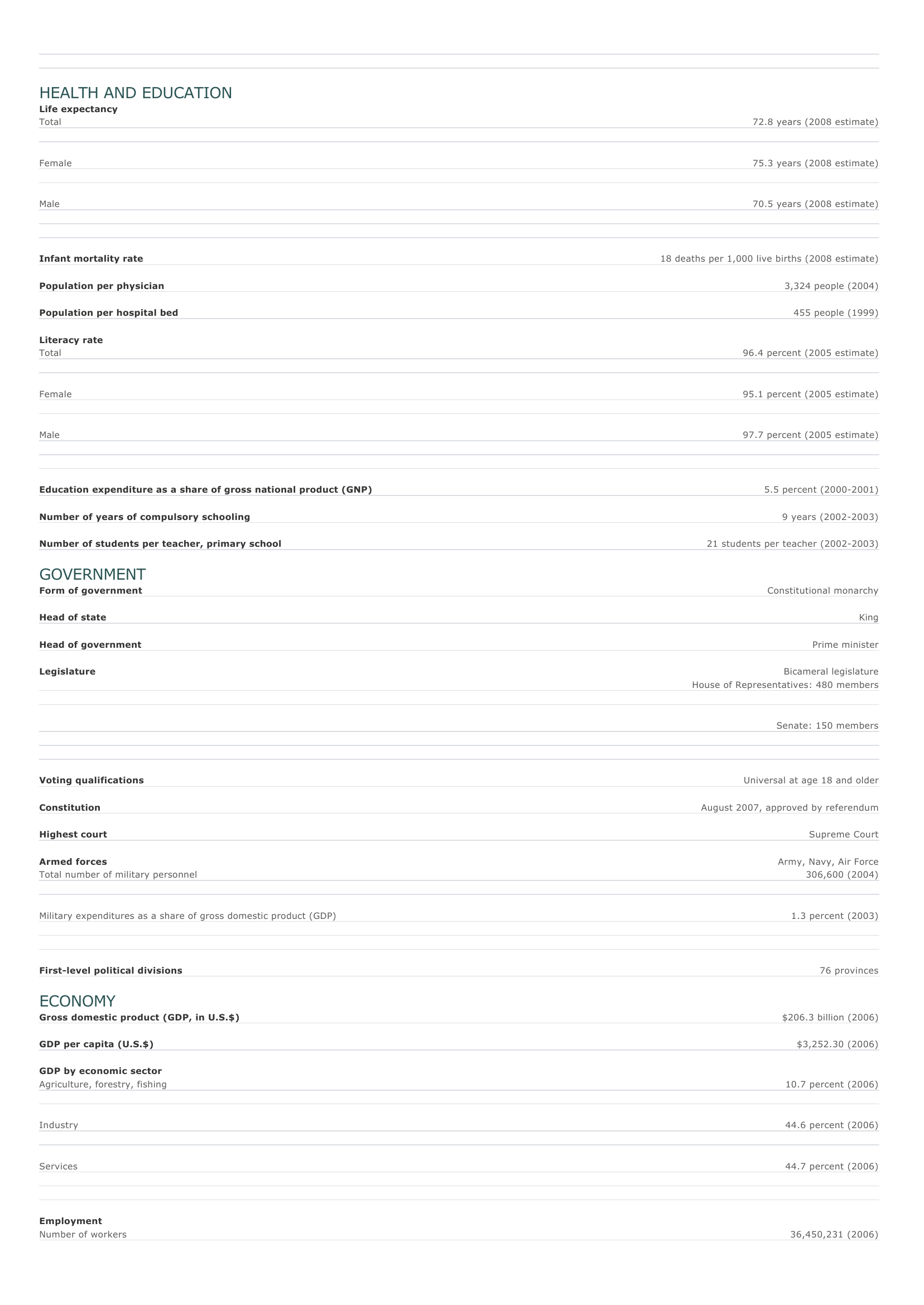Thailand Facts and Figures. BASIC FACTS Official name Capital Area Kingdom of Thailand Bangkok 513,115 sq km 198,115 sq mi PEOPLE Population 65,493,298 (2008 estimate) Population growth Population growth rate 0.64 percent (2008 estimate) Projected population in 2025 70,523,958 (2025 estimate) Projected population in 2050 69,268,817 (2050 estimate) Population density 128 persons per sq km (2008 estimate) 332 persons per sq mi (2008 estimate) Urban/rural distribution Share urban 32 percent (2005 estimate) Share rural 68 percent (2005 estimate) Largest cities, with population Bangkok Nonthaburi Songkhla 6,486,000 (2003 estimate) 291,307 (2000) 288,000 (1998 estimate) Nakhon Ratchasima 204,391 (2000) Chiang Mai 167,776 (2000) Ethnic groups Thai 75 percent Chinese 14 percent Malay 3 percent Khmer, Hmong, Karen, and other 8 percent Languages Thai (official), English, Chinese, Malay, Lao, and Mon-Khmer Religious affiliations Buddhist (Theravada) 85 percent Muslim 7 percent Christian 2 percent Nonreligious 2 percent O ther 4 percent HEALTH AND EDUCATION Life expectancy Total 72.8 years (2008 estimate) Female 75.3 years (2008 estimate) Male 70.5 years (2008 estimate) Infant mortality rate Population per physician Population per hospital bed 18 deaths per 1,000 live births (2008 estimate) 3,324 people (2004) 455 people (1999) Literacy rate Total 96.4 percent (2005 estimate) Female 95.1 percent (2005 estimate) Male 97.7 percent (2005 estimate) Education expenditure as a share of gross national product (GNP) Number of years of compulsory schooling Number of students per teacher, primary school 5.5 percent (2000-2001) 9 years (2002-2003) 21 students per teacher (2002-2003) GOVERNMENT Form of government Head of state Head of government Legislature Constitutional monarchy King Prime minister Bicameral legislature House of Representatives: 480 members Senate: 150 members Voting qualifications Constitution Highest court Armed forces Total number of military personnel Military expenditures as a share of gross domestic product (GDP) First-level political divisions Universal at age 18 and older August 2007, approved by referendum Supreme Court Army, Navy, Air Force 306,600 (2004) 1.3 percent (2003) 76 provinces ECONOMY Gross domestic product (GDP, in U.S.$) GDP per capita (U.S.$) $206.3 billion (2006) $3,252.30 (2006) GDP by economic sector Agriculture, forestry, fishing 10.7 percent (2006) I ndustry 44.6 percent (2006) Services 44.7 percent (2006) Employment Number of workers 36,450,231 (2006) Workforce share of economic sector Agriculture, forestry, fishing 43 percent (2005) I ndustry 20 percent (2005) Services 37 percent (2005) Unemployment rate 1.5 percent (2004) National budget (U.S.$) Total revenue $41,665 million (2006) Total expenditure $33,462 million (2006) Monetary unit 1 baht (B), consisting of 100 satangs Agriculture Rice, cassava, rubber, sugarcane, maize, pineapples, coconuts, kenaf, livestock Mining Natural gas, lignite, gemstones, zinc, lead, tin, gypsum, iron ore, manganese Manufacturing Textiles and garments, electronics and electrical goods, cement, refined sugar, refined petroleum, motor vehicles, cigarettes Major exports Textiles and garments, electronic goods (especially semiconductors), prawns, rice, rubber, precious gems, cassava, sugar Major imports Petroleum and petroleum products, machinery, chemicals, iron and steel Major trade partners for exports United States, Japan, Singapore, Hong Kong SAR, and China Major trade partners for imports Japan, United States, China, Malaysia, and Singapore ENERGY, COMMUNICATIONS, AND TRANSPORTATION Electricity production Electricity from thermal sources Electricity from hydroelectric sources Electricity from nuclear sources Electricity from geothermal, solar, and wind sources 91.51 percent (2003 estimate) 6.31 percent (2003 estimate) 0 percent (2003 estimate) 2.18 percent (2003 estimate) Number of radios per 1,000 people 234 (1997) Number of telephones per 1,000 people 110 (2005) Number of televisions per 1,000 people 281 (2000 estimate) Number of Internet hosts per 10,000 people 16 (2003) Daily newspaper circulation per 1,000 people 65 (1996) Number of motor vehicles per 1,000 people Paved road as a share of total roads SOURCES Basic Facts and People sections 104 (1997) 99 percent (2000) Area data are from the statistical bureaus of individual countries. Population, population growth rate, and population projections are from the United States Census Bureau, International Programs Center, International Data Base (IDB) (www.census.gov). Urban and rural population data are from the Food and Agriculture Organization (FAO) of the United Nations (UN), FAOSTAT database (www.fao.org). Largest cities population data and political divisions data are from the statistical bureaus of individual countries. Ethnic divisions and religion data are largely from the latest Central Intelligence Agency (CIA) World Factbook and from various country censuses and reports. Language data are largely from the Ethnologue, Languages of the World, Summer Institute of Linguistics International (www.sil.org). Health and Education section Life expectancy and infant mortality data are from the United States Census Bureau, International Programs Center, International database (IDB) (www.census.gov). Population per physician and population per hospital bed data are from the World Health Organization (WHO) (www.who.int). Education data are from the United Nations Educational, Scientific and Cultural Organization (UNESCO) database (www.unesco.org). Government section Government, independence, legislature, constitution, highest court, and voting qualifications data are largely from various government Web sites, the latest Europa World Yearbook, and the latest Central Intelligence Agency (CIA) World Factbook. The armed forces data is from Military Balance. Economy section Gross domestic product (GDP), GDP per capita, GDP by economic sectors, employment, and national budget data are from the World Bank database (www.worldbank.org). Monetary unit, agriculture, mining, manufacturing, exports, imports, and major trade partner information is from the statistical bureaus of individual countries, latest Europa World Yearbook, and various United Nations and International Monetary Fund (IMF) publications. Energy, Communication, and Transportation section Electricity information is from the Energy Information Administration (EIA) database (www.eia.doe.gov). Radio, telephone, television, and newspaper information is from the United Nations Educational, Scientific and Cultural Organization (UNESCO) database (www.unesco.org). Internet hosts, motor vehicles, and road data are from the World Bank database (www.worldbank.org). Note Figures may not total 100 percent due to rounding. Microsoft ® Encarta ® 2009. © 1993-2008 Microsoft Corporation. All rights reserved.










